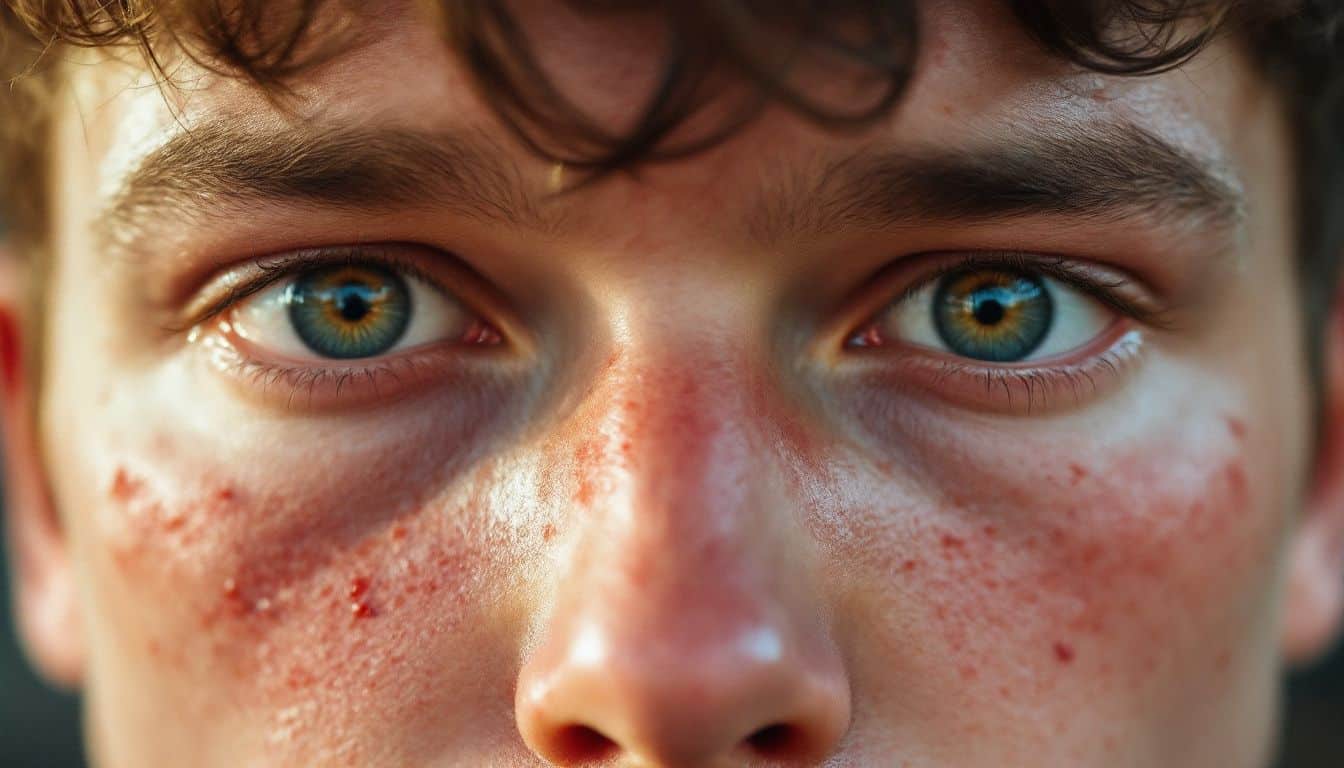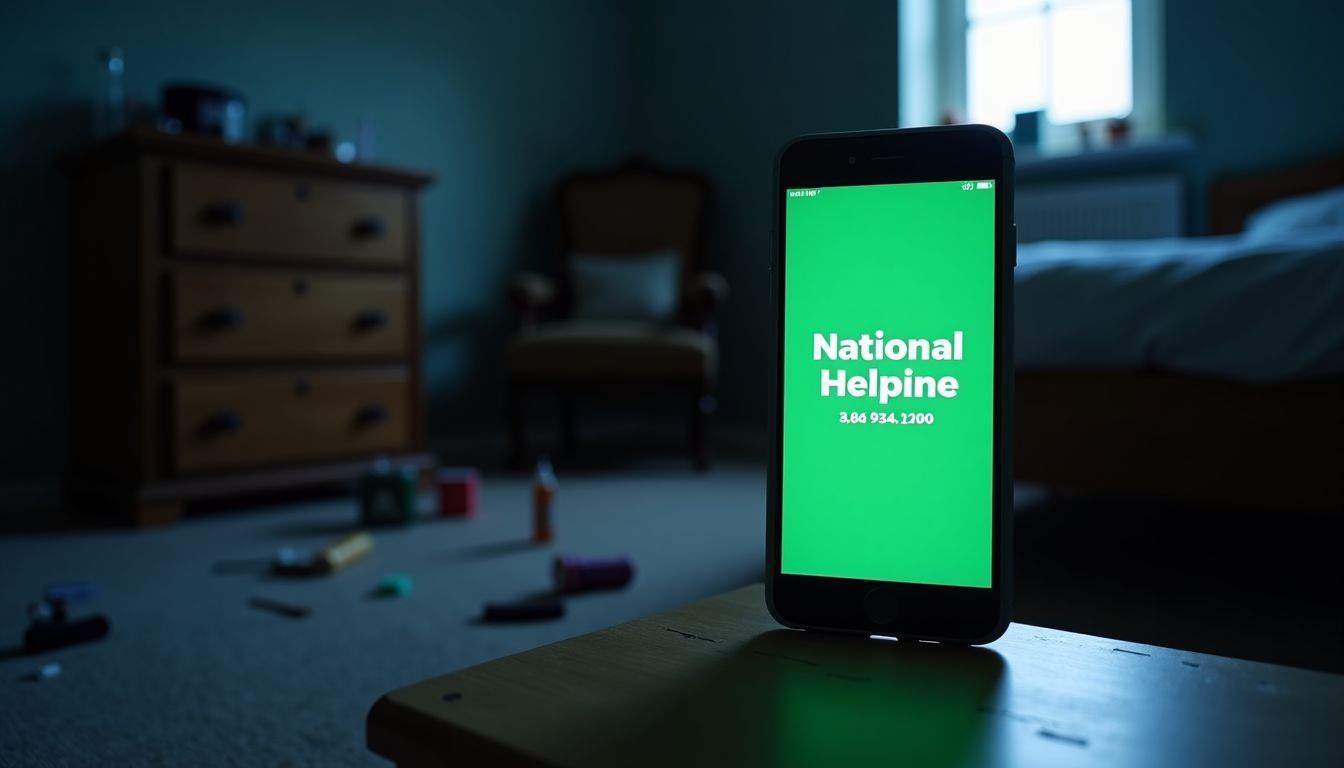Spotting signs of a meth addict in a loved one can feel scary and overwhelming. Recent data shows that nearly 2 million Americans struggle with meth addiction each year. This guide will help you identify 16 key warning signs of meth use and show you practical steps to help someone get treatment.
You’ll learn exactly what to look for and how to take action today.
Key Takeaways
Physical signs of meth use show up fast through rapid weight loss, dental decay (“meth mouth”), skin sores, and large pupils that don’t shrink in bright light.
Behavioral changes include bursts of energy, paranoia (affecting 45% of users), aggressive outbursts (56% link drug use to violence), and loss of interest in daily activities.
Mental health effects create lasting damage – 40% of users face ongoing psychosis, memory problems, and confusion that persist even after stopping meth use.
Users often spend $400-800 weekly on meth, leading to money troubles, legal issues, and pulling away from family and friends.
Long-term meth use raises heart problem risks by 32% and creates a 53% higher chance of heart failure, while causing permanent brain damage that affects memory and focus.
Table of Contents
Physical Signs of Meth Addiction

Physical signs of meth addiction show up fast and clear on a person’s body. You’ll notice quick changes in how someone looks – from sudden weight drops to skin problems that don’t heal well.
Rapid weight loss

Meth users drop weight fast due to the drug’s strong effect on appetite. The stimulant drug speeds up body functions and makes people feel less hungry. Most users shed pounds quickly, leading to a gaunt, unhealthy look.
This rapid weight change often causes serious health problems and makes the body weak. People who need safe meth detox treatment show clear signs of extreme thinness.
Methamphetamine abuse creates a devastating cycle of weight loss and malnutrition that can destroy both body and mind.
The body starts breaking down muscle tissue for energy during meth use. Chronic users face higher risks of anxiety and depression from this extreme weight loss. Their faces often look hollow, with sunken cheeks and dark circles under their eyes.
Many users lose 10–15 pounds within their first few weeks of regular meth use. This quick drop in weight signals a dangerous pattern of substance abuse that needs medical help right away.
Dental issues

Dental problems stand out as a clear sign of meth use, often called “meth mouth” by medical experts. Users face severe tooth decay, gum disease, and jaw pain due to the drug’s harsh chemicals.
The teeth might break, rot, or fall out because meth dries up saliva that protects teeth. Many users grind their teeth hard during drug use, causing more damage to their dental health.
Physical changes from meth use go beyond just bad teeth. The drug causes major weight loss, which affects how well people can care for their teeth and gums. Users often feel strong jaw pain and face muscle problems that make eating difficult.
Poor nutrition mixed with lack of dental care leads to faster tooth decay. These dental issues link closely with skin problems that come next….
Skin sores and scabs

Meth users often get painful sores and scabs on their face and body. These sores pop up from constant picking and scratching at their skin. The marks show up as red, raw patches that can turn into deep wounds or abscesses.
Many users feel like bugs are crawling under their skin, which makes them scratch more.
The sores take a long time to heal and leave lasting scars on the skin. Most users keep picking at their skin even as it tries to heal. The face takes the worst damage, creating what many call “meth face.” These visible marks make it easy to spot someone using meth.
The next warning sign to watch for is dilated pupils, which can point to recent drug use.
Dilated pupils
 Dilated pupils stand out as a clear sign of crystal meth use. The eyes show large, dark centers that don’t shrink in bright light. People using methamphetamine often display these enlarged pupils along with red, puffy eyes.
Dilated pupils stand out as a clear sign of crystal meth use. The eyes show large, dark centers that don’t shrink in bright light. People using methamphetamine often display these enlarged pupils along with red, puffy eyes.
Drug abuse affects the body’s natural response to light, making pupils stay wide open.
The eyes are the window to addiction’s grip on the body. – Dr. Sarah Chen, Addiction Specialist
Physical changes go beyond just the eyes. Many meth users show rapid weight loss and dental problems too. The next major sign appears through skin problems and sores that need attention.
Behavioral Indicators

Meth users show clear changes in how they act – from sudden bursts of energy to scary thoughts about others being out to get them – and these warning signs often point to a deeper struggle that needs quick help from doctors and support groups.
Increased energy or hyperactivity

Stimulant drugs like crystal meth create intense bursts of energy in users. People who use meth often stay awake for days, talking fast without stopping. The drug pushes the body into overdrive, making users feel super alert and active.
Many users clean their homes obsessively or start multiple projects at once. Their actions seem rushed and scattered, with facial twitches showing up during these high-energy periods.
The burst of energy leads to risky choices and non-stop movement. Users might pace around rooms or fidget constantly due to the drug’s effects on their brain chemistry. The intense rush of dopamine makes them feel powerful and unstoppable.
This false sense of endless energy masks the serious damage happening to their bodies. Their hearts race, and blood pressure soars as the stimulant forces their systems to work harder than normal.
Paranoia and suspiciousness

The intense energy from meth use leads to serious mental changes. Paranoia stands out as a major red flag in meth users. Studies show 45% of people who use meth deal with paranoid thoughts.
These thoughts make them see threats that aren’t real. Many users start to distrust their closest friends and family members.
Scary behaviors often follow these paranoid feelings. Research proves that 37% of paranoid meth users got weapons to protect themselves. About 11% actually used these weapons during paranoid episodes.
Most users (67%) hear voices that aren’t there, while 63% see things that don’t exist. These symptoms can put both the drug addict son and others at risk.
The mix of paranoia and substance use disorder creates a dangerous situation that needs quick medical help.
Aggressive or violent outbursts
Meth users often show sudden bursts of anger and violence. Studies reveal that 56% of people who use meth link their drug use to aggressive actions. These outbursts can range from verbal fights to physical attacks without warning.
Many users feel paranoid, which makes them more likely to act violently toward others.
Drug-related violence affects families and relationships deeply. Research shows 59% of meth users have committed violent crimes while under the influence. A person might break things, start fights, or threaten loved ones during these episodes.
Such behavior creates fear and stress for everyone nearby, especially children and partners who live with the user. Support groups and substance abuse treatment can help manage these dangerous symptoms before they cause lasting harm.
Loss of interest in hobbies or responsibilities
A clear red flag of substance use disorder shows up in daily life changes. People stop doing things they once loved, like painting, sports, or spending time with friends. The brain’s reward system shifts focus to the drug, making other activities feel less fun.
Peer pressure makes this worse, especially in young people who use methamphetamine.
The hardest part was watching my sister stop showing up for our weekly tennis matches. Her racket collected dust while meth took over her life.
Life duties often take a back seat during active addiction. Bills pile up, work performance drops, and family ties weaken. Studies from the National Institute on Drug Abuse show that meth users often miss work and school due to their drug use.
Smart Recovery groups report that many members need help rebuilding interest in old hobbies during treatment.
Mental and Emotional Symptoms

Meth use can trigger intense mood swings and racing thoughts that make daily tasks hard to handle. Mental health changes often show up as deep anxiety, memory gaps, and strange fears about people watching or following you.
Anxiety and restlessness
Anxiety grips most meth users, with over 75% facing daily panic and unease. People who use meth often pace back and forth, unable to sit still or relax. Their minds race with worried thoughts while their bodies stay in constant motion.
Studies show 26.2% of people with meth problems also struggle with serious anxiety issues, making recovery harder.
Physical signs of anxiety show up as shaking hands, fast breathing, and heavy sweating. The mix of meth and anxiety leads to poor sleep, jumping at small sounds, and feeling scared in normal situations.
These symptoms get worse without proper help and support. Many users feel trapped between needing the drug and fearing its effects. Mental health problems can persist long after stopping meth use.
The next major sign to watch for involves confusion and memory issues….
Confusion and memory problems
Methamphetamine users experience significant memory problems that impact their daily lives. Research indicates 40% of methamphetamine users show cognitive testing deficits. These issues affect their ability to remember basic tasks or recent events.
Medical imaging shows methamphetamine causes damage to memory and cognitive processing regions of the brain.
Methamphetamine abuse creates lasting damage to memory and cognitive function that can persist long after stopping use. – National Institute on Drug Abuse
The substance destroys brain cells that produce dopamine, causing confusion and concentration difficulties. People with methamphetamine addiction frequently miss important dates, lose time awareness, and find it challenging to absorb new information.
Many users report disorientation in familiar environments or difficulty following basic conversations. These cognitive changes often occur with emotional instability and mood disorders, increasing the difficulty of daily activities.
Depression and emotional instability
Long-term meth use causes deep mood changes and emotional pain. Users often feel hopeless and struggle with severe depression that feels impossible to escape. The brain changes from meth create intense mood swings – from extreme highs to crushing lows.
Many people report feeling trapped in dark thoughts and unable to feel joy in daily life.
Meth-induced psychosis brings scary delusions and voices that sound real but aren’t there. The mix of depression and unstable moods makes normal life very hard. Support groups help many women cope with these mental health effects.
Proper treatment must address both the addiction and mood problems at the same time. The next challenge users face involves dealing with paranoia and suspicious thoughts.
Hallucinations or delusions
Meth users often face scary mental changes that twist their reality. Four out of ten people who use meth see or hear things that aren’t real. These hallucinations feel very real to the person going through them.
A meth user might see bugs crawling under their skin or hear voices telling them scary things. Many users also develop strong false beliefs, like thinking someone is following them or trying to hurt them.
The brain changes from meth use can create lasting psychotic symptoms, even after stopping the drug. Studies show 40% of users deal with ongoing psychosis, which includes both hallucinations and strange beliefs.
These mental effects can pop up during meth use or show up later during withdrawal. People might act strange, talk to themselves, or become very afraid of others around them. Getting help from drug rehab centers becomes vital since these symptoms need proper medical care and support to manage.
Social and Lifestyle Changes

Meth addiction tears through social bonds and daily habits like a tornado. People who struggle with meth often pull away from loved ones and face money troubles, which can lead to stealing or selling personal items to buy drugs.
Withdrawal from family and friends
Social bonds break down fast during substance use disorder. People with meth addiction pull away from loved ones and close friends, leading to deep isolation. Studies show this withdrawal stems from shame, fear of judgment, or the drug’s effects on the brain.
Many users focus only on getting and using the drug, pushing aside meaningful relationships.
Family ties suffer greatly as the substance misuse continues. The person may skip family events, ignore calls, or make excuses to avoid contact. Their peer group often shifts to other drug users who enable harmful behaviors.
This isolation makes recovery harder and increases the risk of ongoing addiction. Financial troubles often follow as work and money problems mount up. Next, we’ll explore how money problems create extra stress for people battling meth addiction.
Financial instability
Meth addiction drains bank accounts fast. Users often spend $400-800 per week on crystal meth, leading to missed bill payments and mounting debts. Many addicts lose their jobs due to poor work performance or frequent absences, making their money problems worse.
The U.S. faces over $420 billion in yearly costs from substance abuse, showing how this drug wreaks havoc on personal and national finances.
People with meth addiction often resort to selling personal items or stealing to fund their habit. They might max out credit cards, empty savings accounts, or take risky loans. Some skip paying for basic needs like food or rent to buy drugs.
The strain on health insurance grows as medical bills pile up from drug-related health issues. These money troubles can trigger legal problems that make recovery even harder.
The next warning sign involves serious legal consequences that often follow meth use…
Legal troubles
Legal problems stack up fast for people caught with crystal methamphetamine. The Combat Methamphetamine Epidemic Act makes possession a serious crime with harsh penalties. Many users face arrest for having drug supplies or making meth in home labs.
Police often find pseudoephedrine and other banned chemicals during searches. A single arrest can lead to jail time, heavy fines, and a criminal record that blocks job opportunities.
Drug-related charges create extra problems for mothers and caregivers. Courts take a strict view of meth use around children. Child protective services may remove kids from homes where drug activity occurs.
Getting clean through addiction treatment programs can help restore custody rights. Support groups offer guidance on dealing with court dates, probation rules, and rebuilding trust with family members.
The legal system aims to stop meth production while helping users recover through drug treatment and behavioral therapy options.
Neglect of personal hygiene
Personal hygiene often takes a back seat during meth addiction. People battling substance use disorder stop caring about basic daily tasks like brushing teeth, showering, or changing clothes.
The decline in self-care points to a deeper issue – the drug’s grip on their daily habits. Many users focus only on getting their next fix, pushing aside basic grooming needs.
Meth users show clear signs through their appearance and hygiene habits. Dental hygiene suffers badly, leading to ‘meth mouth’ with damaged or missing teeth. Body odor becomes strong due to lack of regular showers.
Clothes stay unwashed and worn for days. These changes in personal care match how serious the addiction has become. The next warning sign to watch for involves major shifts in sleep patterns and energy levels.
Long-term Effects of Meth Use

Meth causes serious damage to your brain and body over time – from heart problems to memory loss – and learning more about these effects could save your life or someone you care about.
Chronic insomnia
Long-term meth users face severe sleep problems that can last for months or years. Studies show these users spend more time lying awake and less time in actual sleep. The brain stays alert and active, making it hard to rest properly.
Sleep issues often lead to other health problems like mood swings and poor focus during the day.
People who struggle with stimulant use disorder need proper sleep management to recover. The body needs quality rest to heal from drug damage. Many users report staying awake for days, followed by long crash periods.
This pattern creates a harmful cycle that affects both physical and mental health. The next serious effect of long-term meth use involves persistent psychosis.
Persistent psychosis
Meth use can trigger lasting mental changes in your brain. Studies show that 40% of meth users face persistent psychosis – a serious mental state that continues even after stopping the drug.
This condition brings scary symptoms like hearing voices, feeling bugs crawl under your skin, and extreme paranoia. Many women report these effects lasting for over a month after their last meth use.
The brain changes from substance use disorder create real dangers for daily life. Users often show psychotic behavior, making them pull away from loved ones or act with sudden violence.
The mix of hallucinations and paranoia makes normal tasks feel impossible. Medical detox and cognitive-behavioral therapy offer paths to recovery from these lasting mental effects.
Support groups help women share their struggles and find strength in healing together.
Cardiovascular damage
Long-term drug abuse takes a severe toll on your heart and blood vessels. Studies show that people who use methamphetamines face a 32% higher risk of heart problems. Your heart works harder and faster under the influence, which leads to damaged arteries and weak heart muscles.
The drug forces your blood pressure to spike and creates irregular heartbeats that strain your cardiovascular system.
The dangers to your heart health grow worse over time. Research reveals meth users have a 53% higher chance of heart failure and a 42% increased risk of pulmonary hypertension. These serious conditions can cause chest pain, trouble breathing, and even sudden cardiac events.
Your blood vessels may narrow or become blocked, reducing blood flow to vital organs. The damage often becomes permanent without proper medical care and stopping drug use.
Cognitive decline
Heart problems caused by methamphetamine use often result in brain damage. Research indicates methamphetamine creates significant harm to cognitive functions, including memory and concentration.
Brain imaging shows decreased dopamine levels, affecting thought processes and emotions. Methamphetamine users have difficulty with basic activities requiring attention and rapid cognitive processing.
Methamphetamine users experience severe risks to their cognitive health. The substance impairs working memory and inhibits control over destructive behaviors. Users frequently struggle to retain essential information or maintain focus on routine activities.
These cognitive alterations persist after methamphetamine cessation. Recovery groups and cognitive-behavioral therapy assist users in restoring mental functions during rehabilitation.
What to Do If You Suspect Meth Addiction

Spotting meth addiction signs in a loved one can feel scary, but quick action saves lives. You can start by learning about treatment options and local support services through the National Helpline at 1-800-662-4357.
Approach with care and understanding
Caring support makes a huge difference in helping someone with meth addiction. Pick a peaceful time to talk, like a quiet morning or evening at home. Speak with kindness and skip harsh words that might push them away.
Your calm voice and gentle approach can create trust. Many people avoid getting help because they fear judgment or criticism.
Show you care through small actions and patient listening. Offer to sit with them as they call support groups or treatment centers. Make eye contact and keep your body language open.
Share facts about recovery options without pushing too hard. Focus on their strengths and remind them that addiction treatment works. Your understanding attitude helps build the bridge to professional help and healing.
Support groups provide extra care during the tough parts of recovery.
Encourage professional help
After showing care for your loved one, taking action becomes vital. Professional help offers the best chance for recovery from meth addiction. The Substance Abuse and Mental Health Services Administration (SAMHSA) provides direct access to treatment options near you.
Medical experts can guide patients through withdrawal symptoms and create safe recovery plans. Support groups help build strong networks during the healing process.
Professional treatment centers offer cognitive-behavioral therapy (CBT) to address both addiction and mental health needs. Crisis support stands ready 24/7 through the 988 helpline – just call or text for immediate assistance.
Many health insurers now cover substance use disorder treatments, making recovery more accessible. Local support groups provide extra strength through shared experiences and understanding.
Provide access to support resources
Support starts with a phone call to SAMHSA’s National Helpline at 1-800-662-HELP. This free service runs 24/7 to connect you with caring professionals who understand substance use disorders.
The helpline staff can link you to local treatment centers, support groups, and community resources that fit your needs.
FindTreatment.gov offers a simple way to locate nearby treatment options. The site matches you with facilities based on your location, treatment needs, and payment choices. For immediate crisis support, the 988 Suicide & Crisis Lifeline stands ready to help through phone calls or text messages.
These resources create a safety net of care and guidance for anyone facing meth addiction.
People Also Ask
What are the key signs someone is using crystal meth?
Common signs include dental problems like meth mouth, sleeping problems, high body temperature, and sudden weight loss. People may also show low mood, hopelessness, and major changes in behavior.
How dangerous is a meth overdose?
A meth overdose can be deadly. It may cause seizures, stroke, and very high body temperature. Call for help right away if someone has overdosed – quick action saves lives.
What happens during meth withdrawal?
Withdrawal symptoms often include deep sadness, tiredness, and strong drug cravings. Some people need antidepressants like selective serotonin reuptake inhibitors to help with protracted withdrawal.
How can I help someone with methamphetamine use disorder?
Support them in finding addiction treatment and joining support groups. The national helpline offers free help. Remember that recovery often needs medical care to reduce harm and prevent relapse.
What health risks come with using meth?
Besides substance use disorder, meth can cause serious health issues like Parkinson’s disease, AIDS, and hepatitis B and C. It also leads to severe dental problems and dehydration.
Are there special risks for pregnant women who use meth?
Yes, using methamphetamine while pregnant can harm both mother and baby. It raises risks of stroke, seizures, and other serious health problems. Immediate medical help is crucial.
References
https://americanaddictioncenters.org/stimulants/meth
https://pmc.ncbi.nlm.nih.gov/articles/PMC3764482/
https://www.medicalnewstoday.com/articles/meth-face-sores
https://recoveryservicesct.com/what-do-meth-sores-look-like/
https://compassionbehavioralhealth.com/5-signs-of-meth-use/
https://pmc.ncbi.nlm.nih.gov/articles/PMC10031494/
https://www.orlandorecovery.com/drug-addiction-resources/meth/symptoms-signs-side-effects/
https://pmc.ncbi.nlm.nih.gov/articles/PMC3168774/
https://pmc.ncbi.nlm.nih.gov/articles/PMC4651438/
https://pmc.ncbi.nlm.nih.gov/articles/PMC5027896/
https://pmc.ncbi.nlm.nih.gov/articles/PMC2710245/
https://pmc.ncbi.nlm.nih.gov/articles/PMC3159418/
https://www.sonorabehavioral.com/addiction/meth/symptoms-causes/
https://pmc.ncbi.nlm.nih.gov/articles/PMC5525418/
https://pmc.ncbi.nlm.nih.gov/articles/PMC10657270/
https://pmc.ncbi.nlm.nih.gov/articles/PMC4440680/
https://pmc.ncbi.nlm.nih.gov/articles/PMC9021839/
https://pmc.ncbi.nlm.nih.gov/articles/PMC3260986/
https://www.goodrx.com/conditions/stimulant-use-disorder/how-to-help-with-meth-addiction (2024-09-23)
https://www.samhsa.gov/find-help/helplines/national-helpline
